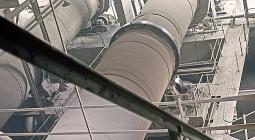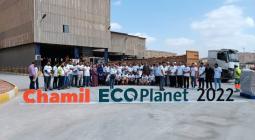The cement that could turn your house into a giant battery

Concrete is perhaps the most commonly used building material in the world. With a bit of tweaking, it could help to power our homes too.
On a laboratory bench in Cambridge, Massachusetts, a stack of polished cylinders of black-coloured concrete sit bathed in liquid and entwined in cables. To a casual observer, they aren't doing much. But then Damian Stefaniuk flicks a switch. The blocks of human-made rock are wired up to an LED – and the bulb flickers into life.
"At first I didn't believe it," says Stefaniuk, describing the first time the LED lit up. "I thought that I hadn't disconnected the external power source, and that was why the LED was on.
"It was a wonderful day. We invited students, and I invited professors to see, because at first they didn't believe that it worked either."
The reason for the excitement? This innocuous, dark lump of concrete could represent the future of energy storage.
The promise of most renewable energy sources is that of endless clean power, bestowed on us by the Sun, wind and sea.
Yet the Sun isn't always shining, the wind isn't always blowing, and still waters do not, in megawatt terms, run deep. These are energy sources that are intermittent, which, in our energy-hungry modern world, poses a problem.
It means that we need to store that energy in batteries. But batteries rely on materials such as lithium, which is in far shorter supply than is likely to be needed to meet the demand created by the world's quest to decarbonise its energy and transport systems. There are 101 lithium mines in the world, and economic analysts are pessimistic about the ability of these mines to keep up with growing global demand. Environmental analysts note that lithium mining uses a lot of energy and water, which nibble away at the environmental benefits of switching to renewable energy sources in the first place. The processes involved in extracting lithium can also sometimes lead to toxic chemicals leaking into local water supplies.
Despite some new discoveries of lithium reserves, the finite supply of this material, the over-reliance on just a handful of mines around the world and its environmental impact have driven the search for alternative battery materials.
This is where Stefaniuk and his concrete come in. He and his colleagues at Massachusetts Institute of Technology (MIT) have found a way of creating an energy storage device known as a supercapacitor from three basic, cheap materials – water, cement and a soot-like substance called carbon black.
Supercapacitors are highly efficient at storing energy but differ from batteries in some important ways. They can charge much more quickly than a lithium ion battery and don't suffer from the same levels of degradation in performance. But supercapacitors also release the power they store rapidly, making them less useful in devices such as mobile phones, laptops or electric cars where a steady supply of energy is needed over an extended period of time.
Yet according to Stefaniuk, carbon-cement supercapacitors could make an important contribution to efforts to decarbonise the global economy. "If it can be scaled up, the technology can help solve an important issue – the storing of renewable energy," he says.
He and his fellow researchers at MIT and Harvard University's Wyss Institute for Biologically Inspired Engineering, envisage several applications for their supercapacitors.
One might be to create roads that store solar energy and then release it to recharge electric cars wirelessly as they drive along a road. The rapid release of energy from the carbon-cement supercapacitor would allow vehicles to get a rapid boost to their batteries. Another would be as energy-storing foundations of houses – "to have walls, or foundations, or columns, that are active not only in supporting a structure, but also in that energy is stored inside them", says Stefaniuk.
But it is still early days. For now, the concrete supercapacitor can store a little under 300 watt-hours per cubic metre – enough to power a 10-watt LED lightbulb for 30 hours.
The power output "may seem low compared to conventional batteries, [but] a foundation with 30-40 cubic metres (1,060-1,410 cubic feet) of concrete could be sufficient to meet the daily energy needs of a residential house", says Stefaniuk. "Given the widespread use of concrete globally, this material has the potential to be highly competitive and useful in energy storage."
Stefaniuk and his colleagues at MIT initially proved the concept by creating cent-sized 1V supercapacitors from the material before connecting together in series to power a 3V LED. They have since scaled this up to produce a 12V supercapacitor. Stefaniuk has also been able to use larger versions of the supercapacitor to power a handheld games console.
And the research team are now planning to build larger versions, including one up to 45 cubic metres (1,590 cubic feet) in size that would be able store around 10kWh of energy needed to power to power a house for a day.
The supercapacitor works due to an unusual property of carbon black – it is highly conductive. This means that when carbon black is combined with cement powder and water, it makes for a kind of concrete that is full of networks of conductive material, taking a form that resembles ever-branching, tiny roots.
Capacitors are formed of two conductive plates with a membrane in between them. In this case, both plates are made of the carbon black cement, which were soaked in an electrolyte salt called potassium chloride.
When an electric current was applied to the salt-soaked plates, the positively-charged plates accumulated negatively charged ions from the potassium chloride. And because the membrane prevented charged ions from being exchanged between the plates, the separation of charges created an electric field.
As supercapacitors can accumulate large amounts of charge very quickly, it could make the devices useful for storing excess energy produced by intermittent renewable sources such as the wind and solar. This would take the pressure off the grid at times when the wind is not blowing, nor the Sun shining. As Stefaniuk says, "A simple example would be an off-grid house powered by solar panels: using solar energy directly during the day and the energy stored in, for example, the foundations during the night."
Supercapacitors are not perfect. Existing iterations discharge power quickly, and are not ideal for steady output, which would be needed to power a house throughout the day. Stefaniuk says he and his colleagues are working on a solution that would allow their carbon-cement version to be tuned by adjusting the mixture, but they will not disclose the details until they have finalised the tests and published a paper.
There could be other issues to overcome too – adding more carbon black allows the resulting supercapacitor to store more energy, but it also makes the concrete slightly weaker too. The researchers say any uses that have a structural role to play as well as energy storage would need to find an optimum mix of carbon black.
And while carbon-cement supercapacitors could help to reduce our reliance on lithium, they come with their own environmental impact. Cement production is responsible for 5-8% of carbon dioxide emissions from human activity globally, and the carbon-cement needed for the supercapacitors would need to be freshly made rather than retrofitted in existing structures.
Nevertheless, it seems to be a promising innovation, says Michael Short, who leads the Centre for Sustainable Engineering at Teesside University in the UK. The research "opens many interesting potential avenues around the use of the built environment itself as an energy storage medium", he says. "As the materials are also commonplace and the manufacture relatively straightforward, this gives a great indication that this approach should be investigated further and could potentially be a very useful part of the transition to a cleaner, more sustainable future."
But more research will be needed to move this from the laboratory into the real world.
"Often, new discoveries are problematic when considerations are made to move from lab or bench scale to wider deployment at larger scales and volumes. This can be due to manufacturing complexities, resource scarcities, or sometimes due to the underlying physics or chemistry. Desirable properties occurring at smaller scales may reduce or even vanish when attempts are made to make it larger."
But there may be a way of overcoming the problem of environmentally-unfriendly cement, adds Short. His colleagues at Teesside University are already working on low-emissions cement that is made from the by-products of the steel and chemical industries.
Projects such as low-emissions cement and energy-storing concrete raise the prospect of a future where our offices, roads and homes play a significant part in a world powered by clean energy.





